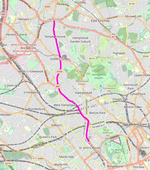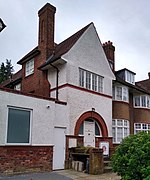Childs Hill

Childs Hill is one of two areas at the south end of the London Borough of Barnet along with Cricklewood which straddles three boroughs. It took its name from Richard le Child, who in 1312 held a customary house and "30 acres" of its area. It is a mainly late-19th-century suburban large neighbourhood centred 5 miles (8 km) northwest of Charing Cross bordered by the arterial road Hendon Way in the west and south-west, Dunstan Road in the north, West Heath and Golders Hill Park which form an arm of Hampstead Heath to the east and the borough boundary as to the short south-east border. Child's Hill reaches relatively high ground in London along its eastern border. Adjoining Hampstead Heath features, less than a mile from the centre of Child's Hill, the summit of London's third-highest escarpment. From 1789 to 1847 Child's Hill hosted an optical telegraph station.
Excerpt from the Wikipedia article Childs Hill (License: CC BY-SA 3.0, Authors, Images).Childs Hill
Finchley Road, London Golders Green (London Borough of Barnet)
Geographical coordinates (GPS) Address Nearby Places Show on map
Geographical coordinates (GPS)
| Latitude | Longitude |
|---|---|
| N 51.563 ° | E -0.197 ° |
Address
Four5Two Finchley Road
Finchley Road 452
NW11 8DG London, Golders Green (London Borough of Barnet)
England, United Kingdom
Open on Google Maps








